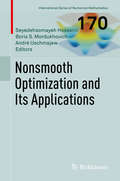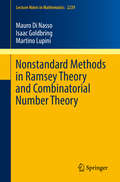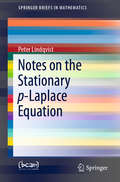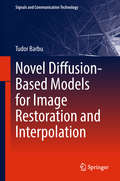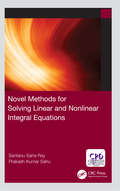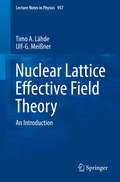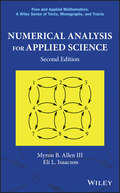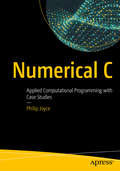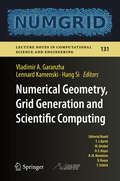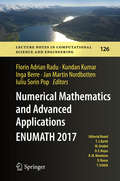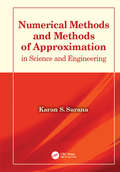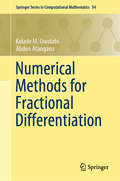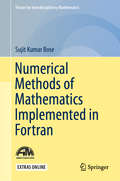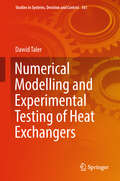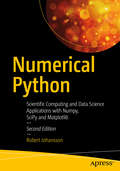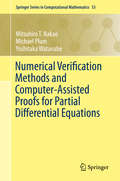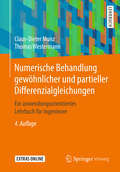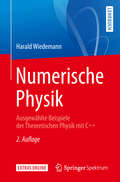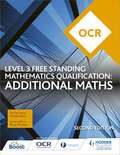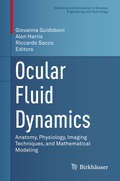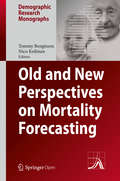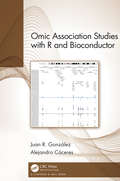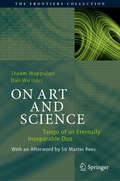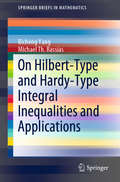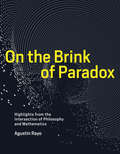- Table View
- List View
Nonsmooth Optimization and Its Applications (International Series of Numerical Mathematics #170)
by Seyedehsomayeh Hosseini Boris S. Mordukhovich André UschmajewSince nonsmooth optimization problems arise in a diverse range of real-world applications, the potential impact of efficient methods for solving such problems is undeniable. Even solving difficult smooth problems sometimes requires the use of nonsmooth optimization methods, in order to either reduce the problem’s scale or simplify its structure. Accordingly, the field of nonsmooth optimization is an important area of mathematical programming that is based on by now classical concepts of variational analysis and generalized derivatives, and has developed a rich and sophisticated set of mathematical tools at the intersection of theory and practice.This volume of ISNM is an outcome of the workshop "Nonsmooth Optimization and its Applications," which was held from May 15 to 19, 2017 at the Hausdorff Center for Mathematics, University of Bonn. The six research articles gathered here focus on recent results that highlight different aspects of nonsmooth and variational analysis, optimization methods, their convergence theory and applications.
Nonstandard Methods in Ramsey Theory and Combinatorial Number Theory (Lecture Notes in Mathematics #2239)
by Mauro Di Nasso Isaac Goldbring Martino LupiniThe goal of this monograph is to give an accessible introduction to nonstandard methods and their applications, with an emphasis on combinatorics and Ramsey theory. It includes both new nonstandard proofs of classical results and recent developments initially obtained in the nonstandard setting. This makes it the first combinatorics-focused account of nonstandard methods to be aimed at a general (graduate-level) mathematical audience. This book will provide a natural starting point for researchers interested in approaching the rapidly growing literature on combinatorial results obtained via nonstandard methods. The primary audience consists of graduate students and specialists in logic and combinatorics who wish to pursue research at the interface between these areas.
Notes on the Stationary p-Laplace Equation (SpringerBriefs in Mathematics)
by Peter LindqvistThis book in the BCAM SpringerBriefs series is a treatise on the p-Laplace equation. It is based on lectures by the author that were originally delivered at the Summer School in Jyväskylä, Finland, in August 2005 and have since been updated and extended to cover various new topics, including viscosity solutions and asymptotic mean values. The p-Laplace equation is a far-reaching generalization of the ordinary Laplace equation, but it is non-linear and degenerate (p>2) or singular (p
Novel Diffusion-Based Models for Image Restoration and Interpolation (Signals and Communication Technology)
by Tudor BarbuThis book covers two essential PDE-based image processing fields: image denoising and image inpainting. It describes the state-of-the-art PDE-based image restoration and interpolation (inpainting) techniques, focusing on the latest advances in PDE-based image processing and analysis, and explores novel techniques involving diffusion-based models and variational schemes. The PDE and variational schemes clearly outperform the conventional approaches in these areas, and can successfully remove image noise and reconstruct missing or highly degraded regions, while preserving the essential features and avoiding unintended effects. The book addresses researchers and graduate students, but is also well suited for professionals in both the mathematics and electrical engineering domains, as it provides rigorous mathematical investigations of the image processing models described, as well as mathematical treatments for the numerical approximation schemes of these differential models.
Novel Methods for Solving Linear and Nonlinear Integral Equations
by Santanu Saha Ray Prakash Kumar SahuThis book deals with the numerical solution of integral equations based on approximation of functions and the authors apply wavelet approximation to the unknown function of integral equations. The book's goal is to categorize the selected methods and assess their accuracy and efficiency.
Nuclear Lattice Effective Field Theory: An Introduction (Lecture Notes in Physics #957)
by Timo A. Lähde Ulf-G. MeißnerThis primer begins with a brief introduction to the main ideas underlying Effective Field Theory (EFT) and describes how nuclear forces are obtained from first principles by introducing a Euclidean space-time lattice for chiral EFT. It subsequently develops the related technical aspects by addressing the two-nucleon problem on the lattice and clarifying how it fixes the numerical values of the low-energy constants of chiral EFT. In turn, the spherical wall method is introduced and used to show how improved lattice actions render higher-order corrections perturbative. The book also presents Monte Carlo algorithms used in actual calculations. In the last part of the book, the Euclidean time projection method is introduced and used to compute the ground-state properties of nuclei up to the mid-mass region. In this context, the construction of appropriate trial wave functions for the Euclidean time projection is discussed, as well as methods for determining the energies of the low-lying excitations and their spatial structure. In addition, the so-called adiabatic Hamiltonian, which allows nuclear reactions to be precisely calculated, is introduced using the example of alpha-alpha scattering. In closing, the book demonstrates how Nuclear Lattice EFT can be extended to studies of unphysical values of the fundamental parameters, using the triple-alpha process as a concrete example with implications for the anthropic view of the Universe. Nuclear Lattice Effective Field Theory offers a concise, self-contained, and introductory text suitable for self-study use by graduate students and newcomers to the field of modern computational techniques for atomic nuclei and nuclear reactions.
Numerical Analysis for Applied Science (Pure and Applied Mathematics: A Wiley Series of Texts, Monographs and Tracts #35)
by Myron B. Allen III Eli L. IsaacsonPragmatic and Adaptable Textbook Meets the Needs of Students and Instructors from Diverse Fields Numerical analysis is a core subject in data science and an essential tool for applied mathematicians, engineers, and physical and biological scientists. This updated and expanded edition of Numerical Analysis for Applied Science follows the tradition of its precursor by providing a modern, flexible approach to the theory and practical applications of the field. As before, the authors emphasize the motivation, construction, and practical considerations before presenting rigorous theoretical analysis. This approach allows instructors to adapt the textbook to a spectrum of uses, ranging from one-semester, methods-oriented courses to multi-semester theoretical courses. The book includes an expanded first chapter reviewing useful tools from analysis and linear algebra. Subsequent chapters include clearly structured expositions covering the motivation, practical considerations, and theory for each class of methods. The book includes over 250 problems exploring practical and theoretical questions and 32 pseudocodes to help students implement the methods. Other notable features include: A preface providing advice for instructors on using the text for a single semester course or multiple-semester sequence of courses Discussion of topics covered infrequently by other texts at this level, such as multidimensional interpolation, quasi-Newton methods in several variables, multigrid methods, preconditioned conjugate-gradient methods, finite-difference methods for partial differential equations, and an introduction to finite-element theory New topics and expanded treatment of existing topics to address developments in the field since publication of the first edition More than twice as many computational and theoretical exercises as the first edition. Numerical Analysis for Applied Science, Second Edition provides an excellent foundation for graduate and advanced undergraduate courses in numerical methods and numerical analysis. It is also an accessible introduction to the subject for students pursuing independent study in applied mathematics, engineering, and the physical and life sciences and a valuable reference for professionals in these areas.
Numerical C: Applied Computational Programming with Case Studies
by Philip JoyceLearn applied numerical computing using the C programming language, starting with a quick primer on the C programming language and its SDK. This book then dives into progressively more complex applied math formula for computational methods using C with examples throughout and a larger, more complete application towards the end. Numerical C starts with the quadratic formula for finding solutions to algebraic equations that model things such as price vs. demand or rise vs. run or slip and more. Later in the book, you'll work on the augmented matrix method for simultaneous equations. You’ll also cover Monte Carlo method model objects that could arise naturally as part of the modeling of a real-life system, such as a complex road network, the transport of neutrons, or the evolution of the stock market. Furthermore, the Monte Carlo method of integration examines the area under a curve including rendering or ray tracing and the shading in a region. Furthermore, you'll work with the product moment correlation coefficient: correlation is a technique for investigating the relationship between two quantitative, continuous variables, for example, age and blood pressure. By the end of the book, you'll have a feeling for what computer software could do to help you in your work and apply some of the methods learned directly to your work. What You Will LearnGain software and C programming basicsWrite software to solve applied, computational mathematics problems Create programs to solve equations and calculus problems Use the trapezium method, Monte Carlo method, line of best fit, product moment correlation coefficient, Simpson’s rule, and matrix solutions Write code to solve differential equations Apply one or more of the methods to an application case studyWho This Book Is ForThose with an existing knowledge of rudimentary mathematics (school level) and some basic programming experience. This is also important to people who may work in mathematics or other areas (for example, life sciences, engineering, or economics) and need to learn C programming.
Numerical Geometry, Grid Generation and Scientific Computing: Proceedings of the 9th International Conference, NUMGRID 2018 / Voronoi 150, Celebrating the 150th Anniversary of G.F. Voronoi, Moscow, Russia, December 2018 (Lecture Notes in Computational Science and Engineering #131)
by Vladimir A. Garanzha Lennard Kamenski Hang SiThe focus of these conference proceedings is on research, development, and applications in the fields of numerical geometry, scientific computing and numerical simulation, particularly in mesh generation and related problems. In addition, this year’s special focus is on Voronoi diagrams and their applications, celebrating the 150th birthday of G.F. Voronoi. In terms of content, the book strikes a balance between engineering algorithms and mathematical foundations. It presents an overview of recent advances in numerical geometry, grid generation and adaptation in terms of mathematical foundations, algorithm and software development and applications. The specific topics covered include: quasi-conformal and quasi-isometric mappings, hyperelastic deformations, multidimensional generalisations of the equidistribution principle, discrete differential geometry, spatial and metric encodings, Voronoi-Delaunay theory for tilings and partitions, duality in mathematical programming and numerical geometry, mesh-based optimisation and optimal control methods. Further aspects examined include iterative solvers for variational problems and algorithm and software development. The applications of the methods discussed are multidisciplinary and include problems from mathematics, physics, biology, chemistry, material science, and engineering.
Numerical Mathematics and Advanced Applications ENUMATH 2017 (Lecture Notes in Computational Science and Engineering #126)
by Florin Adrian Radu Kundan Kumar Inga Berre Jan Martin Nordbotten Iuliu Sorin PopThis book collects many of the presented papers, as plenary presentations, mini-symposia invited presentations, or contributed talks, from the European Conference on Numerical Mathematics and Advanced Applications (ENUMATH) 2017. The conference was organized by the University of Bergen, Norway from September 25 to 29, 2017. Leading experts in the field presented the latest results and ideas in the designing, implementation, and analysis of numerical algorithms as well as their applications to relevant, societal problems.ENUMATH is a series of conferences held every two years to provide a forum for discussing basic aspects and new trends in numerical mathematics and scientific and industrial applications. These discussions are upheld at the highest level of international expertise. The first ENUMATH conference was held in Paris in 1995 with successive conferences being held at various locations across Europe, including Heidelberg (1997), Jyvaskyla (1999), lschia Porto (2001), Prague (2003), Santiago de Compostela (2005), Graz (2007), Uppsala (2009), Leicester (2011), Lausanne (2013), and Ankara (2015).
Numerical Methods and Methods of Approximation in Science and Engineering
by Karan S. SuranaNumerical Methods and Methods of Approximation in Science and Engineering prepares students and other readers for advanced studies involving applied numerical and computational analysis. Focused on building a sound theoretical foundation, it uses a clear and simple approach backed by numerous worked examples to facilitate understanding of numerical methods and their application. Readers will learn to structure a sequence of operations into a program, using the programming language of their choice; this approach leads to a deeper understanding of the methods and their limitations. The text features highlighted examples, numerous problems, and a complete Solutions Manual for instructors.
Numerical Methods for Fractional Differentiation (Springer Series in Computational Mathematics #54)
by Kolade M. Owolabi Abdon AtanganaThis book discusses numerical methods for solving partial differential and integral equations, as well as ordinary differential and integral equations, involving fractional differential and integral operators. Differential and integral operators presented in the book include those with exponential decay law, known as Caputo–Fabrizio differential and integral operators, those with power law, known as Riemann–Liouville fractional operators, and those for the generalized Mittag–Leffler function, known as the Atangana–Baleanu fractional operators. The book reviews existing numerical schemes associated with fractional operators including those with power law, while also highlighting new trends in numerical schemes for recently introduced differential and integral operators. In addition, the initial chapters address useful properties of each differential and integral fractional operator. Methods discussed in the book are subsequently used to solved problems arising in many fields of science, technology, and engineering, including epidemiology, chaos, solitons, fractals, diffusion, groundwater, and fluid mechanics. Given its scope, the book offers a valuable resource for graduate students of mathematics and engineering, and researchers in virtually all fields of science, technology, and engineering, as well as an excellent addition to libraries.
Numerical Methods of Mathematics Implemented in Fortran (Forum for Interdisciplinary Mathematics)
by Sujit Kumar BoseThis book systematically classifies the mathematical formalisms of computational models that are required for solving problems in mathematics, engineering and various other disciplines. It also provides numerical methods for solving these problems using suitable algorithms and for writing computer codes to find solutions. For discrete models, matrix algebra comes into play, while for continuum framework models, real and complex analysis is more suitable. The book clearly describes the method–algorithm–code approach for learning the techniques of scientific computation and how to arrive at accurate solutions by applying the procedures presented. It not only provides instructors with course material but also serves as a useful reference resource. Providing the detailed mathematical proofs behind the computational methods, this book appeals to undergraduate and graduate mathematics and engineering students.The computer codes have been written in the Fortran programming language, which is the traditional language for scientific computation. Fortran has a vast repository of source codes used in real-world applications and has continuously been upgraded in line with the computing capacity of the hardware. The language is fully backwards compatible with its earlier versions, facilitating integration with older source codes.
Numerical Modelling and Experimental Testing of Heat Exchangers (Studies in Systems, Decision and Control #161)
by Dawid TalerThis book presents new methods of numerical modelling of tube heat exchangers, which can be used to perform design and operation calculations of exchangers characterized by a complex flow system. It also proposes new heat transfer correlations for laminar, transition and turbulent flows. A large part of the book is devoted to experimental testing of heat exchangers, and methods for assessing the indirect measurement uncertainty are presented. Further, it describes a new method for parallel determination of the Nusselt number correlations on both sides of the tube walls based on the nonlinear least squares method and presents the application of computational fluid dynamic (CFD) modeling to determine the air-side Nusselt number correlations. Lastly, it develops a control system based on the mathematical model of the car radiator and compares this with the digital proportional-integral-derivative (PID) controller. The book is intended for students, academics and researchers, as well as for designers and manufacturers of heat exchangers.
Numerical Python: Scientific Computing and Data Science Applications with Numpy, SciPy and Matplotlib
by Robert Johansson<p>Leverage the numerical and mathematical modules in Python and its standard library as well as popular open source numerical Python packages like NumPy, SciPy, FiPy, matplotlib and more. This fully revised edition, updated with the latest details of each package and changes to Jupyter projects, demonstrates how to numerically compute solutions and mathematically model applications in big data, cloud computing, financial engineering, business management and more. <p>Numerical Python, Second Edition, presents many brand-new case study examples of applications in data science and statistics using Python, along with extensions to many previous examples. Each of these demonstrates the power of Python for rapid development and exploratory computing due to its simple and high-level syntax and multiple options for data analysis. <p>After reading this book, readers will be familiar with many computing techniques including array-based and symbolic computing, visualization and numerical file I/O, equation solving, optimization, interpolation and integration, and domain-specific computational problems, such as differential equation solving, data analysis, statistical modeling and machine learning. <p>What You'll Learn <p> <li>Work with vectors and matrices using NumPy <li>Plot and visualize data with Matplotlib <li>Perform data analysis tasks with Pandas and SciPy <li>Review statistical modeling and machine learning with statsmodels and scikit-learn <li>Optimize Python code using Numba and Cython</li> <p> <p>Who This Book Is For: <p> <li>Developers who want to understand how to use Python and its related ecosystem for numerical computing. </li></p>
Numerical Verification Methods and Computer-Assisted Proofs for Partial Differential Equations (Springer Series in Computational Mathematics #53)
by Mitsuhiro T. Nakao Michael Plum Yoshitaka WatanabeRecently, various mathematical problems have been solved by computer-assisted proofs, among them the Kepler conjecture, the existence of chaos, the existence of the Lorenz attractor, the famous four-color problem, and more. In many cases, computer-assisted proofs have the remarkable advantage (compared with a “theoretical” proof) of providing accurate quantitative information.The authors have been working more than a quarter century to establish the verified computations of solutions for partial differential equations, mainly to the nonlinear elliptic problems of the form -∆u=f(x,u,∇u) with Dirichlet boundary conditions. Here, by "verified computation" is meant a computer-assisted numerical approach to proving the existence of a solution in a close and explicit neighborhood of an approximate solution. Therefore, the quantitative information by the technique shown here should also be significant from the viewpoint of the a posteriori error estimates for approximate solution of concerned partial differential equations with mathematically rigorous sense.In this monograph, the authors describe a survey on the verified computations or computer-assisted proofs for partial differential equations that they developed. In Part I, the methods mainly studied by authors Nakao and Watanabe are presented. These methods are based on the finite dimensional projection and the constructive a priori error estimates for the finite element approximation of the Poisson equation. In Part II, the computer-assisted approaches via eigenvalue bounds developed by the second author, Plum, are explained in detail. The main task of this method consists of eigenvalue bounds for the corresponding nonlinear problems of the linearized operators. Some brief remarks are also given on other approaches in Part III. Each method in Parts I and II is followed by appropriate numerical examples that confirm the actual usefulness of the authors’ methods. Also in some examples the practical computer algorithms are supplied so that readers can easily implement the verification program by themselves.
Numerische Behandlung gewöhnlicher und partieller Differenzialgleichungen: Ein anwendungsorientiertes Lehrbuch für Ingenieure
by Claus-Dieter Munz Thomas WestermannDie Autoren vermitteln die Herleitung numerischer Algorithmen zur Lösung von Differenzialgleichungen und geben einen Einblick in die praktische Implementierung. Anhand von Beispielen und Übungsaufgaben mit Problemstellungen aus der Ingenieurspraxis werden Eigenschaften und Einsatzbereiche der verschiedenen Verfahren erläutert. Die beiliegende CD-ROM enthält neben den Lösungswegen auch eine interaktive Version des Buchs. Mithilfe des Computer-Algebra-Systems MAPLE können die beschriebenen Verfahren direkt aus dem Text heraus ausgeführt werden.
Numerische Physik: Ausgewählte Beispiele der Theoretischen Physik mit C++ (Springer-Lehrbuch)
by Harald WiedemannDieses Lehrbuch stellt die Numerische Physik anhand einer Vielzahl von Beispielen aus den Bereichen Mechanik, Elektrodynamik, Optik, Statistischer Physik und Quantenmechanik dar. Der Leser lernt hier nicht nur die wichtigsten numerischen Techniken in der Programmiersprache C++ kennen, sondern erhält auch neue Einblicke in die Physik, die konventionelle Zugänge nicht bieten. Das Werk schließt damit eine Lücke zwischen den Standardlehrbüchern der Theoretischen Physik und denen der reinen Programmierung.Zu jedem der physikalischen Themen gibt es eine kurze Wiederholung des theoretischen Hintergrunds und anschließend werden ausgewählte Beispiele im Detail ausgearbeitet. Übungen am Ende des Kapitels bieten weitere Gelegenheit die Anwendungen des Gelernten zu vertiefen.Das Buch richtet sich vornehmlich an Physikstudierende höherer Semester, die bereits über eine Basis in Theoretischer Physik verfügen und auch Grundkenntnisse in der Programmierung in C++ mitbringen.Auf der Produktseite zum Buch auf springer.com finden sich alle Quelltexte zu den Programmen im Buchtext zum Download. Im Anhang erhalten Sie eine Zusammenstellung und Erläuterung frei verfügbarer Software, die sowohl dem Windows-Anwender als auch dem Linux-Freund alle Werkzeuge an die Hand gibt, die er zur Bearbeitung anspruchsvoller physikalischer Fragestellungen benötigt - von Compilern über numerische Bibliotheken bis hin zu Visualisierungstools.
OCR Level 3 Free Standing Mathematics Qualification: Additional Maths (2nd edition)
by Val Hanrahan Andrew GintyExam Board: OCRLevel: Free Standing Mathematics QualificationSubject: Additional MathematicsFirst Teaching: September 2018First Exam: Summer 2019Enhance the skills learnt at GCSE and build the confidence to tackle higher-level Mathematics using this comprehensive textbook, tailored to the new OCR Additional Mathematics specification (2018).· Consolidate GCSE Maths skills and prepare for A-level using hundreds of questions designed to bridge the gap between Key Stages 4 and 5.· Expand on GCSE knowledge and confidently tackle new concepts with clear introductions to every topic and plenty of worked examples throughout.· Boost performance in Additional Maths and A-level Maths with expert guidance from subject specialists with extensive examining experience.· Save time planning lessons using our free schemes of work that link to the relevant Integral resources.· Approach your final assessment with confidence, by completing two full practice papers at the end of the book.
Ocular Fluid Dynamics: Anatomy, Physiology, Imaging Techniques, and Mathematical Modeling (Modeling and Simulation in Science, Engineering and Technology)
by Giovanna Guidoboni Alon Harris Riccardo SaccoThe chapters in this contributed volume showcase current theoretical approaches in the modeling of ocular fluid dynamics in health and disease. By including chapters written by experts from a variety of fields, this volume will help foster a genuinely collaborative spirit between clinical and research scientists. It vividly illustrates the advantages of clinical and experimental methods, data-driven modeling, and physically-based modeling, while also detailing the limitations of each approach. Blood, aqueous humor, vitreous humor, tear film, and cerebrospinal fluid each have a section dedicated to their anatomy and physiology, pathological conditions, imaging techniques, and mathematical modeling. Because each fluid receives a thorough analysis from experts in their respective fields, this volume stands out among the existing ophthalmology literature.Ocular Fluid Dynamics is ideal for current and future graduate students in applied mathematics and ophthalmology who wish to explore the field by investigating open questions, experimental technologies, and mathematical models. It will also be a valuable resource for researchers in mathematics, engineering, physics, computer science, chemistry, ophthalmology, and more.
Old and New Perspectives on Mortality Forecasting (Demographic Research Monographs)
by Tommy Bengtsson Nico KeilmanThis open access book describes methods of mortality forecasting and discusses possible improvements. It contains a selection of previously unpublished and published papers, which together provide a state-of-the-art overview of statistical approaches as well as behavioural and biological perspectives. The different parts of the book provide discussions of current practice, probabilistic forecasting, the linearity in the increase of life expectancy, causes of death, and the role of cohort factors. The key question in the book is whether it is possible to project future mortality accurately, and if so, what is the best approach. This makes the book a valuable read to demographers, pension planners, actuaries, and all those interested and/or working in modelling and forecasting mortality.
Omic Association Studies with R and Bioconductor
by Juan R. González Alejandro CáceresAfter the great expansion of genome-wide association studies, their scientific methodology and, notably, their data analysis has matured in recent years, and they are a keystone in large epidemiological studies. Newcomers to the field are confronted with a wealth of data, resources and methods. This book presents current methods to perform informative analyses using real and illustrative data with established bioinformatics tools and guides the reader through the use of publicly available data. Includes clear, readable programming codes for readers to reproduce and adapt to their own data. Emphasises extracting biologically meaningful associations between traits of interest and genomic, transcriptomic and epigenomic data Uses up-to-date methods to exploit omic data Presents methods through specific examples and computing sessions Supplemented by a website, including code, datasets, and solutions
On Art and Science: Tango of an Eternally Inseparable Duo (The Frontiers Collection)
by Shyam Wuppuluri Dali WuEinstein once remarked "After a certain high level of technical skill is achieved, science and art tend to coalesce in aesthetics, plasticity, and form. The greatest scientists are always artists as well". In this volume, some of the world’s leading thinkers come together to expound on the interrelations between sciences and arts. While one can segregate art and place it outside the scientific realm, it is, nevertheless, inextricably linked to our essential cognitive/emotional/perceptual modalities and abilities, and therefore lies alongside and in close contact with the method of science and philosophy. What inspiration can scientists draw from art and how can scientific spirit foster our understanding and creation of aesthetic works? How are art and science grounded in our cognition? What role does perception play in science and art? Are criteria for beauty in art and science the same? How does evolution shape our understanding of art? How do science, art and scientifico-artistic frameworks shape society as a whole and help us address its pressing issues? The epistemological and ontological aspects haunt artists, philosophers and scientists alike. The essays in this volume address these manifold questions while also elucidating the pragmatic role they play in our daily life.
On Hilbert-Type and Hardy-Type Integral Inequalities and Applications (SpringerBriefs in Mathematics)
by Bicheng Yang Michael Th. RassiasThis book is aimed toward graduate students and researchers in mathematics, physics and engineering interested in the latest developments in analytic inequalities, Hilbert-Type and Hardy-Type integral inequalities, and their applications. Theories, methods, and techniques of real analysis and functional analysis are applied to equivalent formulations of Hilbert-type inequalities, Hardy-type integral inequalities as well as their parameterized reverses. Special cases of these integral inequalities across an entire plane are considered and explained. Operator expressions with the norm and some particular analytic inequalities are detailed through several lemmas and theorems to provide an extensive account of inequalities and operators.
On the Brink of Paradox: Highlights from the Intersection of Philosophy and Mathematics (The\mit Press Ser.)
by Agustin RayoAn introduction to awe-inspiring ideas at the brink of paradox: infinities of different sizes, time travel, probability and measure theory, and computability theory.This book introduces the reader to awe-inspiring issues at the intersection of philosophy and mathematics. It explores ideas at the brink of paradox: infinities of different sizes, time travel, probability and measure theory, computability theory, the Grandfather Paradox, Newcomb's Problem, the Principle of Countable Additivity. The goal is to present some exceptionally beautiful ideas in enough detail to enable readers to understand the ideas themselves (rather than watered-down approximations), but without supplying so much detail that they abandon the effort. The philosophical content requires a mind attuned to subtlety; the most demanding of the mathematical ideas require familiarity with college-level mathematics or mathematical proof.The book covers Cantor's revolutionary thinking about infinity, which leads to the result that some infinities are bigger than others; time travel and free will, decision theory, probability, and the Banach-Tarski Theorem, which states that it is possible to decompose a ball into a finite number of pieces and reassemble the pieces so as to get two balls that are each the same size as the original. Its investigation of computability theory leads to a proof of Gödel's Incompleteness Theorem, which yields the amazing result that arithmetic is so complex that no computer could be programmed to output every arithmetical truth and no falsehood. Each chapter is followed by an appendix with answers to exercises. A list of recommended reading points readers to more advanced discussions. The book is based on a popular course (and MOOC) taught by the author at MIT.
